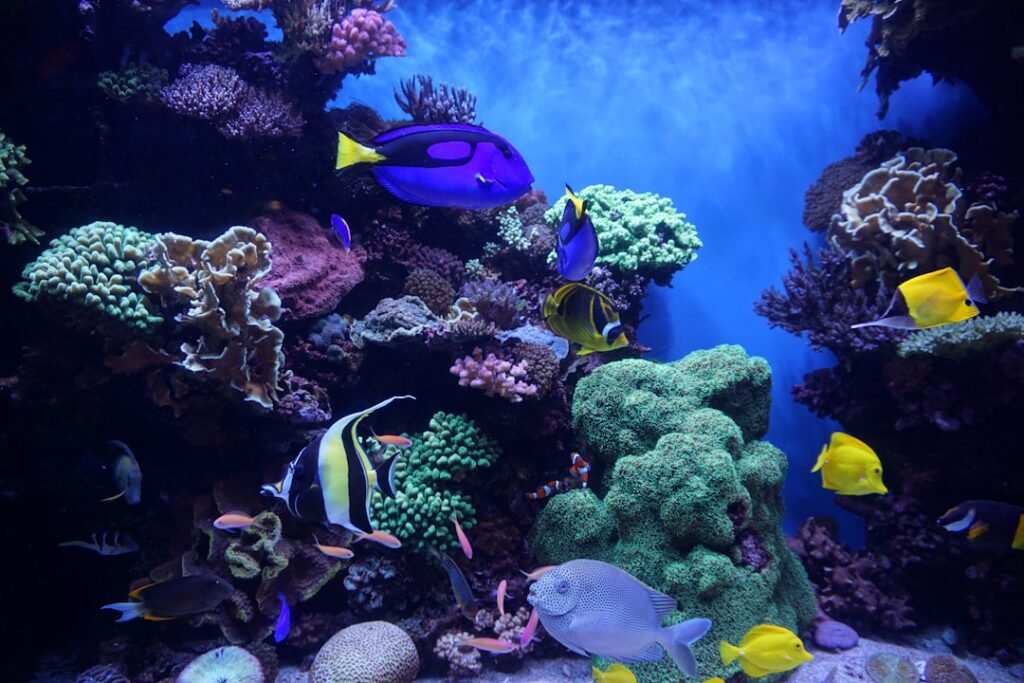Picture yourself floating above a coral reef in crystal-clear tropical waters. You’re mesmerized by the vibrant colors of brain coral and swaying sea fans when you notice something unexpected. Through your snorkel mask, the reef sounds like a bustling underwater city – pops, grunts, scrapes, and crackles fill your ears. This isn’t just background noise; it’s actually one of nature’s most sophisticated navigation systems, broadcasting underwater signals that help bring life back to dying reefs.
Scientists have discovered that these natural reef sounds act like acoustic beacons, drawing young fish and even coral larvae from miles away. The breakthrough research reveals something extraordinary: degraded reefs fall silent, but playing recordings of healthy reef sounds can lure marine life back to damaged areas. This acoustic rescue mission could be one of the most promising tools in our fight to save coral ecosystems worldwide.
The Underwater Symphony That Started It All

Healthy coral reefs are remarkably noisy places – the crackle of snapping shrimp and the whoops and grunts of fish combine to form a dazzling biological soundscape. Think of it as nature’s most elaborate orchestra, where every musician plays a crucial role. Juvenile fish home in on these sounds when they’re looking for a place to settle.
Recorded using underwater microphones, this cacophony can sound to our ears remarkably like frying bacon. Yet beneath this chaotic symphony lies a complex communication network that has been operating for millions of years. Fish species create their own distinctive sounds during feeding, territorial disputes, and mating rituals, while invertebrates add their own acoustic signatures to the mix.
When Reefs Go Silent

Reefs become ghostly quiet when they are degraded, as the shrimps and fish disappear. This silence creates an acoustic desert that repels the very creatures needed for ecosystem recovery. No sound means that fish that have just hatched and are looking for a home swim away from dead coral areas and go elsewhere to settle.
It can take 10-15 years or longer for a reef to recover from a bleaching event. During this extended period, the absence of sound continues to drive away potential colonizers. The reef becomes trapped in a vicious cycle where silence breeds more silence, preventing natural recovery processes from taking hold.
The Breakthrough Discovery

Gordon and his colleagues at the University of Exeter set up underwater speakers and played sounds they recorded from healthy coral areas. The number of fish doubled. This groundbreaking experiment proved that acoustic enrichment could work as a restoration tool. Working on Australia’s recently devastated Great Barrier Reef, the scientists placed underwater loudspeakers playing healthy reef recordings in patches of dead coral and found twice as many fish arrived — and stayed — compared to equivalent patches where no sound was played.
After six weeks of these midnight serenades, the noisy sites were home to twice as many fish than the silent ones. The results were so dramatic that they opened up entirely new possibilities for reef restoration. Researchers had stumbled upon a technique that could accelerate natural recovery processes using nothing more than sound.
How Fish Actually Hear Underwater

The audiograms of the six species were of similar shape, with best hearing at lower frequencies between 100 and 300 Hz. Larvae of the coral reef species had significantly more sensitive hearing than the larvae of the pelagic species. This enhanced hearing ability gives reef fish larvae a remarkable advantage in the open ocean. The results suggest that settlement-stage larval reef fishes may be able to detect reef sounds at distances of a few 100 m.
If hearing plays a role in orientation behavior in the pelagic larvae of coral reef fishes then their unremarkable ears are sufficient to allow these diminutive fishes to carry out the extraordinary feat of navigating the open ocean and successfully locating coral reefs on which to settle. These tiny larvae, no bigger than rice grains, possess sophisticated acoustic detection systems that rival modern navigation technology.
The Star Performers of the Reef Orchestra

The ‘frying’ sound is produced by snapping shrimp (Alpheidae). These small shrimp – about three to five centimetres long – use their unique pincers to produce a very loud ‘pop’ of bubbles that’s so powerful it can stun or kill small fish, which the shrimp eat. They can snap that claw at a speed of over 25 meters per second. When they do, a giant cavitation bubble, or air bubble, forms. Then water rushes back into the air bubble, generating powerful energy and providing both a weapon for the shrimp and a loud snapping sound.
The observed snap rates vary from 1500–2000 snaps per minute during summer to <100 snaps per minute during winter. Sound pressure levels are positively correlated with snap rate and vary seasonally by ~15 decibels in the 1.5–20 kHz range. These tiny crustaceans are essentially the bass section of the reef orchestra, providing the constant background rhythm that defines healthy coral communities.
Fish Songs and Communication Networks

Fish Songs and Communication Networks (Image Credits: Unsplash)
Coral reef fishes produce a wide range of low-frequency pops, grunts, gurgles and croaks while they feed, fight, court and mate. In fact, much like birds, some fish species sing at dawn and dusk, and sometimes through the night, in underwater choruses. Different species have their own vocal signatures, creating a complex acoustic landscape that changes throughout the day.
Various reef-associated fishes, such as damselfish, surgeonfish, and butterflyfish, also generate pulsed sounds of a few hundred hertz during agonistic and reproductive behaviors, as well as scraping of reef substrate during feeding behaviors. Fish sounds can form acoustic mass phenomena in spawning aggregations when multiple calls coalesce into a long-duration chorus, turning a coral reef into a concert hall for soniferous fish.
Coral Larvae Join the Acoustic Party

Using in situ choice chambers, we found that settling coral larvae were attracted to reef sounds, produced mainly by fish and crustaceans, which we broadcast underwater using loudspeakers. This discovery revolutionized our understanding of coral biology. Our discovery that coral larvae can detect and respond to sound is the first description of an auditory response in the invertebrate phylum Cnidaria, which includes jellyfish, anemones, and hydroids as well as corals.
They don’t have brains or ears, but studies have discovered they are sound-sensitive, probably through their tiny hairs (epidermal cilia) that detect vibrations. These microscopic structures allow coral larvae to sense the acoustic signatures of healthy reefs, guiding them to suitable settlement sites during their brief free-swimming phase.
Modern Acoustic Restoration Techniques

To test this theory, Mooney worked with WHOI engineer Ben Weiss and others to build an underwater “acoustic enhancement system.” The initial prototype consisted of a swimming pool speaker attached to a float, equipped with batteries powered by a solar panel, and a micro-SD chip of soundscape recordings. This innovative approach represents a new frontier in marine conservation technology.
At the acoustically enhanced site, we found much more settlement – 2 to 3 times more – than without enhancement. In other words, the soundscape playback had worked, inducing larvae to settle at rates higher than even those at the healthy reef. These remarkable results demonstrate that artificial acoustic enhancement can actually outperform natural reef attraction in some circumstances.
The Science Behind Sound Detection

For sound to be a useful settlement cue, pelagic larvae must be able to detect it far from the source. Soundscapes of temperate rocky coastal reefs may be detected up to 10–25 km offshore by hydrophones and tropical coral reefs have been distinguished up to a few km. The physics of underwater sound propagation allows these acoustic signals to travel remarkable distances through the ocean.
Given the limits of hearing capabilities of larvae, suitable habitats may only be detectable by larvae within a few hundreds of meters. This creates a critical window where larvae must be within acoustic range to receive the settlement cues. Understanding these detection limits helps scientists optimize speaker placement and sound intensity for maximum effectiveness in restoration projects.
Real-World Success Stories

WHOI said the coral “settled at rates 1.7 times (and up to 7x) higher in a degraded environment enriched by recorded sounds than at reefs where no sounds were added, underscoring the power and potential of this enrichment technique.” These dramatic improvements occurred across multiple species and habitat types. The experiment confirmed that the underwater concert attracts up to seven times more coral larvae and fish than a decimated reef without acoustic enrichment.
She said her team saw fish gathering by the speakers too, something she hopes could lead to a positive cycle. “If you are able to attract some of these animals to an area that maybe they aren’t going to for some reason, and if they’re able to survive and thrive there, then they are going to start producing those sounds and those cues that will attract more animals back.”
Conclusion

The discovery that coral reefs use sound as an underwater recruitment system represents one of the most significant breakthroughs in marine conservation. Whilst attracting more fish won’t save coral reefs on its own, new techniques like this give us more tools in the fight to save these precious and vulnerable ecosystems. From local management innovations to international political action, we need meaningful progress at all levels to paint a better future for reefs worldwide.
Boosting fish populations using sounds of healthy coral reefs has the potential to help nurse degraded reefs back to health, researchers say. This acoustic approach offers hope for restoration efforts worldwide, though it must be combined with broader conservation strategies addressing climate change and pollution. What fascinates you more – the idea that tiny coral larvae can navigate by sound, or that we can now help rebuild entire ecosystems using underwater speakers? Share your thoughts in the comments.

Hi, I’m Andrew, and I come from India. Experienced content specialist with a passion for writing. My forte includes health and wellness, Travel, Animals, and Nature. A nature nomad, I am obsessed with mountains and love high-altitude trekking. I have been on several Himalayan treks in India including the Everest Base Camp in Nepal, a profound experience.



